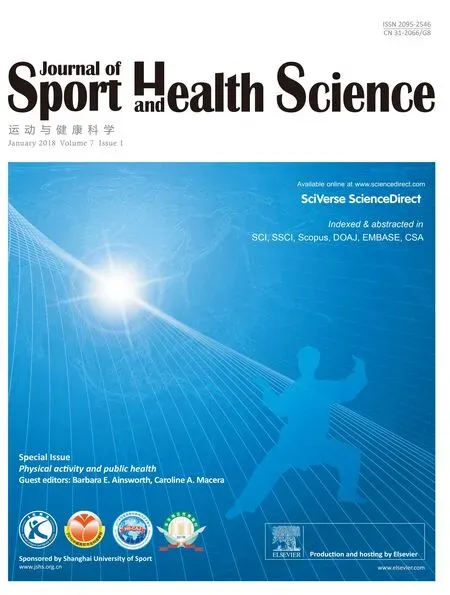Translating science to inform global policy on physical activity
Fiona Bull
aSurveillance and Population Based Prevention,Prevention of Noncommunicable Disease,World Health Organization,Geneva 27,Switzerland
bSchool of Human Science,The University of Western Australia,Crawley,WA 6009,Australia
Regular physical activity (PA) provides well established multiple health benefits and can improve physical,mental,and social health for people of all ages.In 2004,the World Health Organization(WHO)launched the first global strategy on diet and PA,1which urged all countries to implement a set of recommended policy actions to increase levels of participation.Despite much optimism that this strategy would be a catalyst to global progress in the field of PA,reflections on the last decade have shown an inadequate response in breadth,scale,and impact.2
The latest available data show that, worldwide,23% of adults and 81%of adolescents(aged 11-17 years)do not meet the global recommendations.3However,the prevalence of inactivity varies considerably within and between countries and reaches as high as 80%in some populations,and levels of inactivity increase with economic development(as measured by gross domestic product)due to the influence of changing patterns of transportation,use of technology,urbanization,and cultural values.Of particular concern are the significant inequities seen in many countries,with girls,women,older adults,less advantaged,the poor,people with disabilities and chronic disease,and rural communities,having lower levels of PA due to poor access to safe,accessible,affordable places,and appropriate opportunities to be physically active that meet their needs.
Barriers to progress on PA in many countries,particularly in Asia,Africa,and Latin America,include the lack of local evidence to inform and convince government decision and policy makers to prioritize and resource implementation of PA interventions.There is also a need for more sharing of intervention resources and positive experiences within and between countries and regions.This special issue of theJournal of Sport and Health Sciencehas a global perspective on the science and practice of PA,which brings new evidence from a diverse set of countries to share knowledge and inform global and national progress.This is timely,as in 2017 WHO was mandated to develop a new global action plan on PA to reignite global efforts and align national responses toward promoting PA within the new opportunities and agenda set by the 2030 Sustainable Development Goals.Launch of this new action plan is planned for mid-2018 and feedback from the wide consultation undertaken to date is already ensuring that the latest scientific evidence informs the proposed menu of effective policy opportunities.
Based on the strong body of international evidence,it is clear that countries will need to respond with policy actions aimed at ensuring that all people have supportive environments that provide equitable access to safe,appropriate spaces and places for PA,combined with policies that strengthen the provision of programs and opportunities,across multiple settings,tailored to the needs of populations,particularly the least active,disadvantaged,and marginalized communities.Effective policy implementation to increase the population level of PA,and to reduce inequities,will require successful engagement and partnerships with many sectors outside of health,which include transport,urban planning,sports,and education.Cities,local municipalities,schools,and workplaces are key settings and well placed to lead local change and share successful projects to increase both political and community awareness of the importance of everyone being more active,at all ages and according to ability.
Overcoming the institutional and professional challenges to work effectively across government and in partnership with non-government,civil society,and private sectors will be essential.This challenge also presents an opportunity to the research and scientific community not only because multisector partnerships are embedded in the Sustainable Development Agenda but also because much more needs to be known about how to effectively establish and maintain such working arrangements to optimize the different contributions each discipline can contribute.Understanding and assessing the impact of different models of how health,sport,transport,and other sectors can effectively combine to impact levels of participation in different contexts and cultures is a pressing research priority.
There is no time to lose.The 2011 High Level Meeting on Non-communicable Diseases(NCDs)4and the resulting Political Declaration and WHO Global Action Plan on NCDs Prevention and Control2013-20205placed a priority on addressing NCDs risk factors and,in turn,their determinants.Targets were set and for the first time a global target of reducing physical inactivity by 10%by 2025 provided a clear focus for action.Achieving this target will require all countries to support their national actions plans with strong systems of research,surveillance,governance, financing,and advocacy.Building capacity in all of these areas will require the leadership and contributions of the academic and scientific community to assist policy makers and practitioners.It is only by all sectors and the global community joining together in strong cooperation that we can achieve the shared goal of more active societies by 2025.More information on the development and process of the global action plan is available and wide engagement from all sectors is welcomed and encouraged.6
Competing interests
The author is a staff member of the World Health Organization.The author alone is responsible for the views expressed in this publication and they do not necessarily represent the decisions or policies of the World Health Organization.
1.World Health Organization.Global strategy on diet,physical activity and health.Geneva:World Health Organization;2004.
2.International Society for Physical Activity and Health(ISPAH).The Bangkok declaration on physical activity for global health and sustainable development.Br J Sports Med2017;51:1389-91.
3.World Health Organization.Global status report on noncommunicable diseases 2014.Geneva:World Health Organization;2014.
4.United Nations General Assembly.Political declaration of the high-level meeting of the general assembly on the prevention and control of non-communicable diseases.New York,NY:United Nations General Assembly;2011.
5.World Health Organization.Global action plan for the prevention and control of noncommunicable diseases 2013-2020.Geneva:World Health Organization;2013.
6.World Health Organization.Governance:development of a draft global action plan to promote physical activity.Available at:http://www.who.int/ncds/governance/physical_activity_plan/en/;2017[accessed 08.10.2017].
 Journal of Sport and Health Science2018年1期
Journal of Sport and Health Science2018年1期
- Journal of Sport and Health Science的其它文章
- Promoting physical activity in a public health context
- Exercise vs.high altitude therapy
- Physical activity guidelines for Chinese children and adolescents:The next essential step
- “Excessive muscle strain as the direct cause of injury”should not be generalized to hamstring muscle strain injury in sprinting
- Effect of different intensities of physical activity on cardiometabolic markers and vascular and cardiac function in adult rats fed with a high-fat high-carbohydrate diet
- What do coaches want to know about sports-related concussion?A needs assessment study
